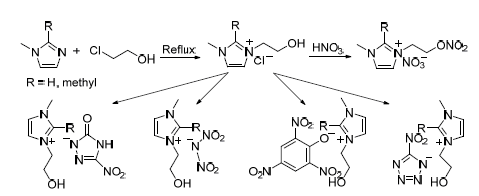| [1] (a) Zhang, Q.-H.; Shreeve, J. M. Chem. Rev. 2014, 114, 10527.
(b) Cui, W.-H.; Zhang, Y.-P.; Jia, R.-Y.; Wang, Y.; Wei, T.-B. Chin. J. Org. Chem. 2015, 35, 890 (in Chinese).
(崔文辉, 张有明, 贾如琰, 王昱, 魏太保, 有机化学, 2015, 35, 890.) (c) Xu, H.; Gui, Q.-F.; Chen, Z.-H.; Qu, H.-R.; Yu, X.-H. Chin. J. Org. Chem.2015, 35, 1910 (in Chinese).
(徐辉, 桂奇飞, 谌志华, 曲浩然, 虞心红, 有机化学, 2015, 35, 1910.) (d) Zhao, S.-H.; Wang, D.; Wang, M.; Kang, J.; Zhang, L. Chin. J. Org. Chem. 2015, 35, 865 (in Chinese).
(赵三虎, 王豆, 王敏, 康锦, 张立, 有机化学, 2015, 35, 865.)
[2] (a) Drake, G.; Hawkins, T.; Brand, A.; Hall, L.; McKay, M.; Vij, A.; Ismail, I. Propellants, Explos., Pyrotech. 2003, 28, 174.
(b) Wang, R.-H.; Guo, Y.; Zeng, Z.; Twamley, B.; Shreeve. J. M. Chem. Eur. J. 2009, 15, 2625.
(c) Schneider, S.; Hawkins, T.; Rosander, M.; Mills, J.; Brand, A.; Hudgens, L.; Warmoth, G.; Vij, A. Inorg. Chem. 2008, 47, 3617.
(d) Tao, G.-H.; Guo, Y.; Joo, Y.; Twamley, B.; Shreeve, J. M. J. Mater. Chem. 2008, 18, 5524.
(e) He, L.; Tao, G.-H.; Parrish, D. A.; Shreeve, J. M. Inorg. Chem. 2011, 50, 679.
[3] (a) Katritzky, A. R.; Yang, H.; Zhang, D.; Kirichenko, K.; Smiglak, M.; Holbrey, J. D.; Reichert, W. M.; Rogers, R. D. New J. Chem. 2006, 30, 349.
(b) Dong, L.-L.; He, L.; Liu, H.-Y.; Tao, G.-H.; Nie, F.-D.; Huang, M.; Hu, C.-W. Eur. J. Inorg. Chem. 2013, 2013, 5009.
(c) Smiglak, M.; Hines, C. C.; Wilson, T. B.; Singh, S.; Vincek, A. S.; Kirichenko, K.; Katritzky, A. R.; Rogers, R. D. Chem. Eur. J. 2010, 16, 1572.
[4] (a) Lin, Q.-H.; Li, Y.-C.; Li, Y.-Y.; Wang, Z.; Liu, W.; Qi, C.; Pang, S.-P. J. Mater. Chem. 2012, 22, 666.
(b) Tao, G.-H.; Huang, Y.; Boatz, J. A.; Shreeve, J. M. Chem. Eur. J. 2008, 14, 11167.
(c) Xue, H.; Gao, H.-X.; Twamley, B.; Shreeve, J. M. Chem. Mater. 2007, 19, 1731.
[5] (a) Klapötke, T. M.; Stierstorfer, J. Dalton Trans. 2009, 643.
(b) Xue, H.; Arritt, S. W.; Twamley, B.; Shreeve, J. M. Inorg. Chem. 2004, 43, 7972.
(c) Klapötke, T. M.; Miró Sabaté, C.; Rusan, M. Z. Anorg. Allg. Chem. 2008, 634, 688.
[6] (a) Sabate, C. M.; Delalu, H.; Jeanneau, E. Chem. Asian J. 2012, 7, 1085.
(b) Sabate, C. M.; Delalu, H.; Jeanneau, E. Chem. Asian J. 2012, 7, 2080.
(c) Sabaté, C. M.; Jeanneau, E.; Delalu, H. Eur. J. Inorg. Chem. 2012, 2012, 2418.
[7] (a) Mehrkesh, A.; Karunanithi, A. T. ACS Sustainable Chem. Eng. 2013, 1, 448.
(b) Ma, C.-M.; Liu, Z.-L.; Xu, X.-J.; Yao, Q.-Z. Chin. J. Org. Chem. 2014, 34, 1288 (in Chinese).
(马丛明, 刘祖亮, 许晓娟, 姚其正, 有机化学, 2014, 34, 1288.) (c) Li, N.; Chai, C.-P.; Gan, Z.-Y.; Luo, Y.-J. Chin. J. Energy Mater. 2010, 18, 467 (in Chinese).
(李娜, 柴春鹏, 甘志勇, 罗运军, 含能材料, 2010, 18, 467.)
[8] (a) Katritzky, A. R.; Singh, S.; Kirichenko, K.; Holbrey, J. D.; Smiglak, M.; Reichert, W. M.; Rogers, R. D. Chem. Commun. 2005, 868.
(b) Smiglak, M.; Hines, C. C.; Reichert, W. M.; Vincek, A. S.; Katritzky, A. R.; Thrasher, J. S.; Sun, L.; McCrary, P. D.; Beasley, P. A.; Kelley, S. P.; Rogers, R. D. New J. Chem. 2012, 36, 702.
(c) Wang, R.-H.; Gao, H.-X.; Ye, C.-F.; Shreeve, J. M. Chem. Mater.2006, 19, 144.
[9] Smiglak, M.; Hines, C. C.; Reichert, W. M.; Shamshina, J. L.; Beasley, P. A.; McCrary, P. D.; Kelley, S. P.; Rogers, R. D. New J. Chem. 2013, 37, 1461.
[10] Schneider, S.; Hawkins, T.; Rosander, M.; Mills, J.; Vaghjiani, G.; Chambreau, S. Inorg. Chem. 2008, 47, 6082.
[11] Tao, G.-H.; Tang, M.; He, L.; Ji, S.-P.; Nie, F.-D.; Huang, M. Eur. J. Inorg. Chem. 2012, 2012, 3070.
[12] Schneider, S.; Hawkins, T.; Rosander, M.; Vaghjiani, G.; Chambreau, S.; Drake, G. Energy Fuels 2008, 22, 2871.
[13] Zhang, Q.-H.; Yin, P.; Zhang, J.-H.; Shreeve, J. M. Chem. Eur. J. 2014, 20, 6909.
[14] Branco, L. C.; Rosa, J. N.; Ramos, J. J. M.; Afonso, C. A. M. Chem. Eur. J. 2002, 8, 3671.
[15] (a) Vokin, A. I.; Sherstyannikova, L. V.; Kanitskaya, L. V.; Abzaeva, K. A.; Lopyrev, V. A.; Turchaninov, V. K.Russ. J. Gen. Chem. 2001, 71, 1708.
(b) Bottaro, J. C.; Penwell, P. l E.; Schmitt, R. J. J. Am. Chem. Soc. 1997, 119, 9405.
(c) Eisaku, N.; Takagaki, M.; Nakaoka, C.; Uchida, M.; Taniguchi, H. J. Org. Chem. 1999, 64, 3151.
[16] (a) Wang, R.-H.; Gao, H.-X.; Ye, C.-F.; Twamley, B.; Shreeve, J. M. Inorg. Chem. 2007, 46, 932.
(b) Gao, Y.; Gao, H.-X.; Piekarski, C.; Shreeve, J. M. Eur. J. Inorg. Chem. 2007, 2007, 4965.
(c) Li, Z.-M.; Yan, Y.-J.; Ji, H.-Y.; Zhang, J.-G.; Zhang, T.-L.; Yang, L. Chin. J. Explos. Propellants 2009, 32, 6 (in Chinese).
(李志敏, 严英俊, 冀慧莹, 张建国, 张同来, 杨利, 火炸药学报, 2009, 32, 6.)
[17] Li, J.-R. Trans. Beijing. Inst. Technol. 1998, 18, 518 (in Chinese).
(李加荣, 北京理工大学学报, 1998, 18, 518.)
[18] Song, J.-R.; Chen, Z.-X.; Xiao, H.-M.; Hu, R.-Z.; Li, F.-P.; Yu, K.-B. Acta Chim. Sinica 1998, 56, 270 (in Chinese).
(宋纪蓉, 陈兆旭, 肖鹤鸣, 胡荣祖, 李福平, 郁开北, 化学学报, 1998, 56, 270.)
[19] Nazeri, G. H.; Mastour, R.; Fayaznia, M. Iran. J. Chem. Chem. Eng. 2008, 27, 85.
[20] D'Aprano, A.; Sesta, B. J. Phys. Chem. 1987, 91, 2415.
[21] Mihelj, T.; Tomasic, V.; Biliskov, N.; Liu, F. Spectrochim. Acta, Part A 2015, 124, 12.
[22] (a) Murotani, M.; Mura, H.; Takeda, M.; Shibafuchi, H. EP 669325, 1994.[Chem. Abstr. 1995, 124, 29762] (b) Klapotke, T. M.; Sabate, C. M.; Welch, J. M. Dalton Trans. 2008, 6372.
[23] Sun, C.-H.; Li, Y.-C.; Li, Y.-Y.; Li, G.-Q.; Pang, S.-P. Chin. J. Org. Chem. 2010, 30, 424 (in Chinese).
(孙成辉, 李玉川, 李亚裕, 李冠琼, 庞思平, 有机化学, 2010, 30, 424.)
[24] Sun, J.; Zhang, S.-J.; Cheng, W.-G.; Ren, J.-Y. Tetrahedron Lett. 2008, 49, 3588. |
